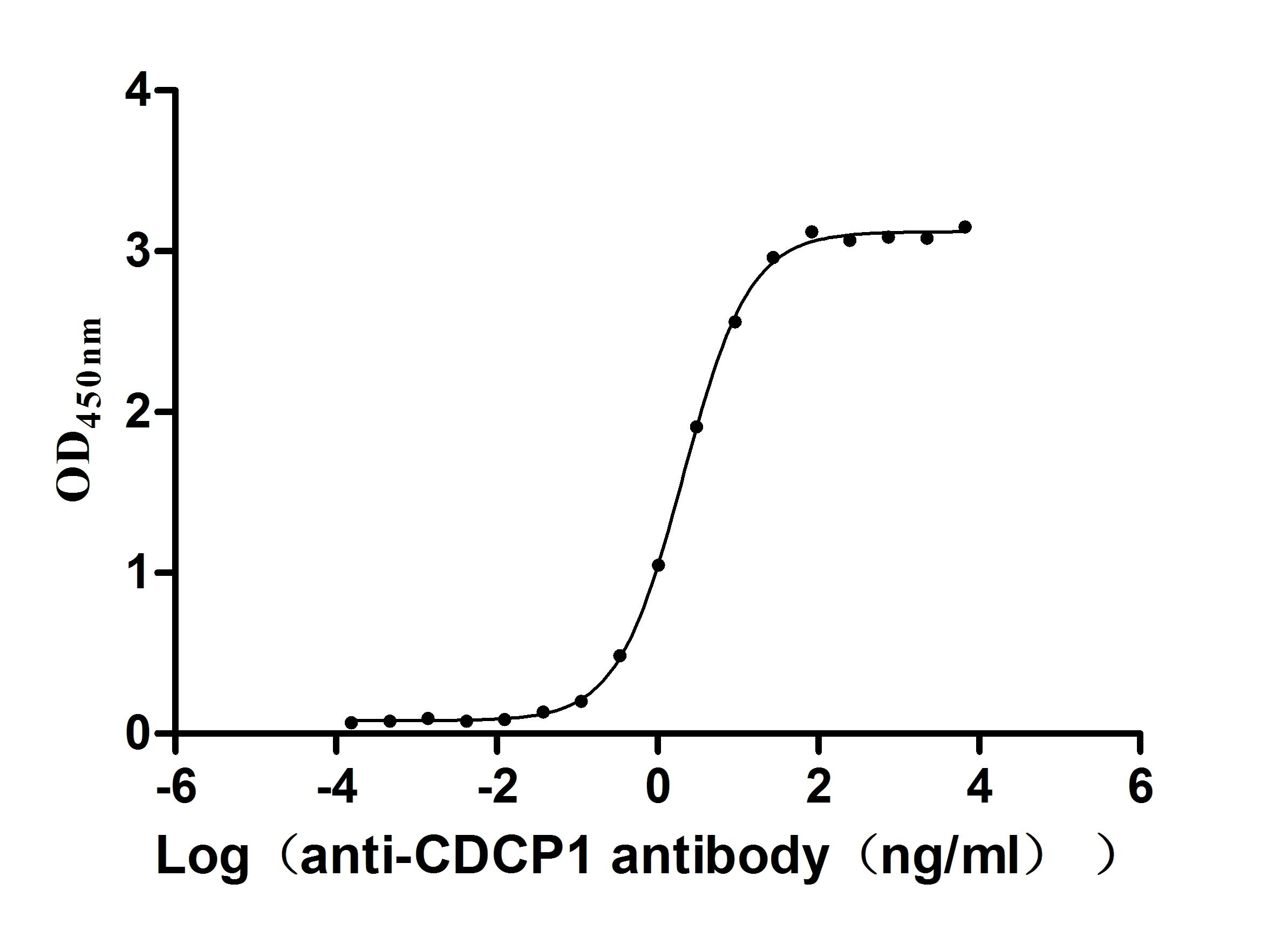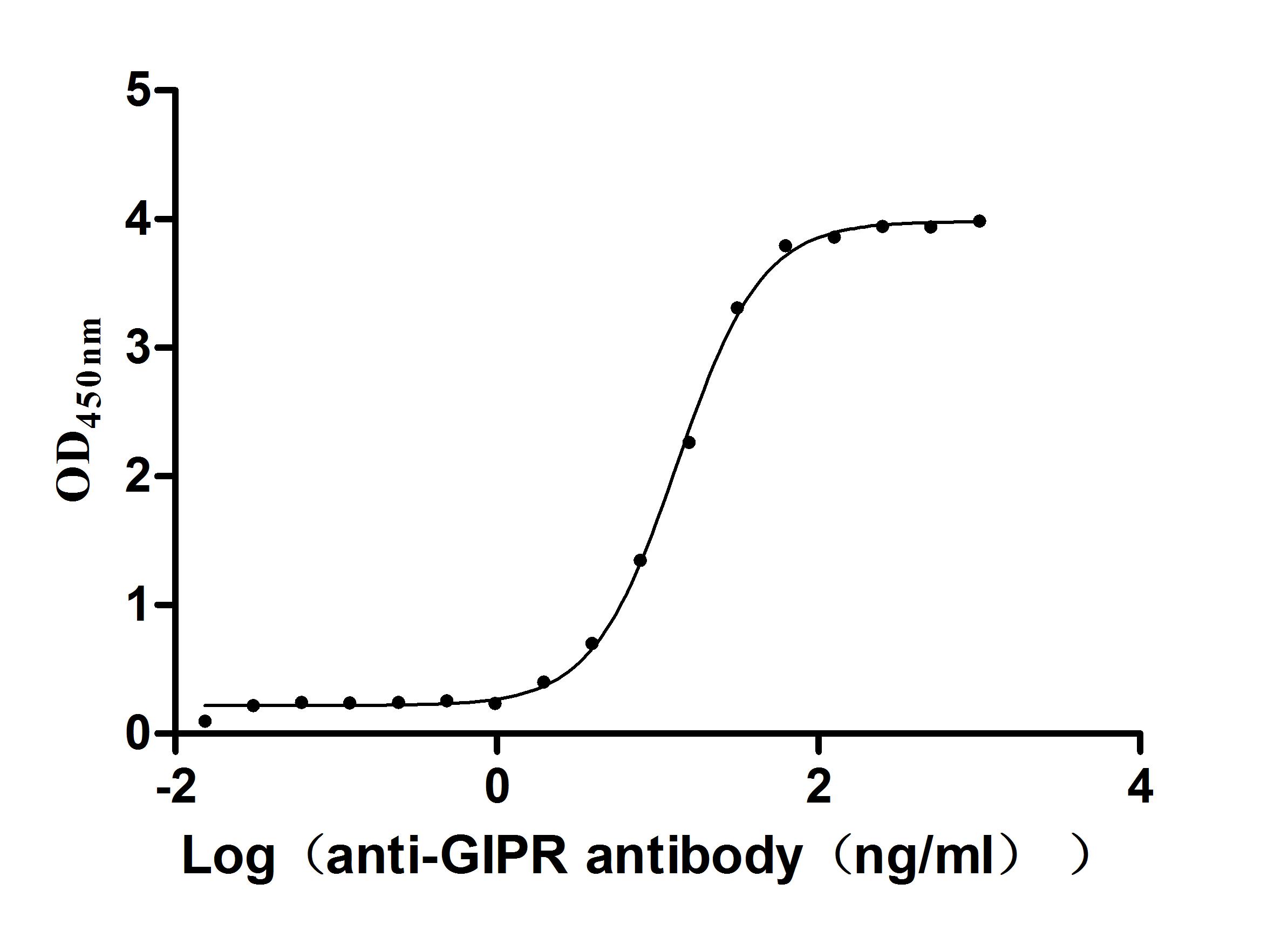Recombinant Human Ubiquitin thioesterase OTUB1 (OTUB1), partial
In Stock-
货号:CSB-RP035954h
-
规格:¥1344
-
图片:
-
其他:
产品详情
-
纯度:Greater than 90% as determined by SDS-PAGE.
-
基因名:OTUB1
-
Uniprot No.:
-
别名:Deubiquitinating enzyme OTUB1; hOTU1; HSPC263; OTB1; OTU domain containing ubiquitin aldehyde binding protein 1; OTU domain, ubiquitin aldehyde binding 1; OTU domain-containing Ubal-binding protein 1; OTU domain-containing ubiquitin aldehyde-binding protein 1; OTU-domain Ubal-binding 1; OTU1; Otub1; OTUB1_HUMAN; Otubain 1; Otubain-1; Ubiquitin specific processing protease OTUB1; Ubiquitin thioesterase OTUB1; ubiquitin-specific protease otubain 1; Ubiquitin-specific-processing protease OTUB1
-
种属:Homo sapiens (Human)
-
蛋白长度:Partial
-
来源:E.coli
-
分子量:50.1kDa
-
表达区域:2-201aa
-
氨基酸序列AAEEPQQQKQEPLGSDSEGVNCLAYDEAIMAQQDRIQQEIAVQNPLVSERLELSVLYKEYAEDDNIYQQKIKDLHKKYSYIRKTRPDGNCFYRAFGFSHLEALLDDSKELQRFKAVSAKSKEDLVSQGFTEFTIEDFHNTFMDLIEQVEKQTSVADLLASFNDQSTSDYLVVYLRLLTSGYLQRESKFFEHFIEGGRTVK
Note: The complete sequence including tag sequence, target protein sequence and linker sequence could be provided upon request. -
蛋白标签:N-terminal GST-tagged
-
产品提供形式:Liquid or Lyophilized powder
Note: We will preferentially ship the format that we have in stock, however, if you have any special requirement for the format, please remark your requirement when placing the order, we will prepare according to your demand. -
缓冲液:Tris-based buffer,50% glycerol
-
储存条件:Store at -20°C/-80°C upon receipt, aliquoting is necessary for mutiple use. Avoid repeated freeze-thaw cycles.
-
保质期:The shelf life is related to many factors, storage state, buffer ingredients, storage temperature and the stability of the protein itself.
Generally, the shelf life of liquid form is 6 months at -20°C/-80°C. The shelf life of lyophilized form is 12 months at -20°C/-80°C. -
货期:3-7 business days
-
注意事项:Repeated freezing and thawing is not recommended. Store working aliquots at 4°C for up to one week.
-
Datasheet & COA:Please contact us to get it.
相关产品
靶点详情
-
功能:Hydrolase that can specifically remove 'Lys-48'-linked conjugated ubiquitin from proteins and plays an important regulatory role at the level of protein turnover by preventing degradation. Regulator of T-cell anergy, a phenomenon that occurs when T-cells are rendered unresponsive to antigen rechallenge and no longer respond to their cognate antigen. Acts via its interaction with RNF128/GRAIL, a crucial inductor of CD4 T-cell anergy. Isoform 1 destabilizes RNF128, leading to prevent anergy. In contrast, isoform 2 stabilizes RNF128 and promotes anergy. Surprisingly, it regulates RNF128-mediated ubiquitination, but does not deubiquitinate polyubiquitinated RNF128. Deubiquitinates estrogen receptor alpha (ESR1). Mediates deubiquitination of 'Lys-48'-linked polyubiquitin chains, but not 'Lys-63'-linked polyubiquitin chains. Not able to cleave di-ubiquitin. Also capable of removing NEDD8 from NEDD8 conjugates, but with a much lower preference compared to 'Lys-48'-linked ubiquitin.; Plays a key non-catalytic role in DNA repair regulation by inhibiting activity of RNF168, an E3 ubiquitin-protein ligase that promotes accumulation of 'Lys-63'-linked histone H2A and H2AX at DNA damage sites. Inhibits RNF168 independently of ubiquitin thioesterase activity by binding and inhibiting UBE2N/UBC13, the E2 partner of RNF168, thereby limiting spreading of 'Lys-63'-linked histone H2A and H2AX marks. Inhibition occurs by binding to free ubiquitin: free ubiquitin acts as an allosteric regulator that increases affinity for UBE2N/UBC13 and disrupts interaction with UBE2V1. The OTUB1-UBE2N/UBC13-free ubiquitin complex adopts a configuration that mimics a cleaved 'Lys48'-linked di-ubiquitin chain.
-
基因功能参考文献:
- Overexpression of OTUB1 (OTU domain-containing ubiquitin aldehyde binding protein 1) in hepatocellular carcinoma (HCC) could be a supplementary biomarker for HCC because it plays a vital role in the progression of HCC. PMID: 28575188
- Silencing of OTU domain-containing ubiquitin aldehyde-binding protein 1 (OTUB1) inhibits migration of human glioma cells in vitro. Study results suggested that OTUB1 was a valuable marker in the pathogenesis of human gliomas and could be used as a novel biomarker for glioma therapy in the future. PMID: 28139865
- Data suggest that inhibiting OTUB1-FOXM1 interaction is a potential avenue for ovarian cancer therapy. PMID: 27167337
- Data indicate that knockdown of otubain 1 protein (Otub1) reduced the levels of double minute 4 protein (MDMX). PMID: 28035068
- OTUB1 may play an important role in colon cancer development and metastasis. PMID: 24947413
- An increase of OTUB1 expression is commonly observed in non-small-cell lung carcinomas harboring wild-type KRAS and is associated with increased levels of ERK1/2 phosphorylation, high Ki67 score, and poorer patient survival. PMID: 26881969
- the data suggest that OTUB1 limits the ubiquitination and degradation of FOXM1 in breast cancer and has a key role in genotoxic agent resistance. PMID: 26148240
- substrate for hydroxylation by FIH on N22 PMID: 26752685
- Data show that casein kinase 2 (CK2)-mediated phosphorylation of deubiquitylating enzyme OTUB1 at Ser16 causes nuclear accumulation of OTUB1. PMID: 25872870
- OTUB1 promoted the metastasis of CRC cell lines. PMID: 25431208
- After viral infection, HSCARG interacted with tumor necrosis receptor-associated factor 3 (TRAF3) and inhibited its ubiquitination by promoting the recruitment of OTUB1 to TRAF3. PMID: 24763515
- These data reveal novel insights into the Otub1 inhibition of E2 wherein monoubiquitination promotes the interaction of Otub1 with UbcH5 and the function to suppress it. PMID: 24403071
- OTUB1 enhances TGF-beta signaling by inhibiting the ubiquitylation and degradation of active SMAD2 and SMAD3. PMID: 24071738
- A second role of OTUB1-E2 interactions is to stimulate OTUB1 cleavage of Lys48 polyubiquitin. This stimulation is regulated by the ratio of charged to uncharged E2 and by the concentration of Lys48-linked polyubiquitin and free ubiquitin. PMID: 23955022
- These results suggest that OTUB1 regulates NF-kappaB and MAPK signalling pathways and TNF-dependent cell death by modulating c-IAP1 stability. PMID: 23524849
- the crystal structure of human OTUB1 in complex with human UBC13 and MMS2 PMID: 22679021
- structural and biochemical studies elucidating how OTUB1 inhibits UBC13 and other E2 enzymes PMID: 22367539
- OTUB1 therefore co-opts Lys48-linked ubiquitin chain recognition to suppress ubiquitin conjugation and the DNA damage response PMID: 22325355
- Overexpression of Otub1(D88A) or ablation of endogenous Otub1 by siRNA markedly impaired p53 stabilization and activation in response to DNA damage. Together, these results reveal a novel function for Otub1 in regulating p53 stability and activity PMID: 22124327
- OTUB1, a deubiquitinating enzyme, is an inhibitor of double-strand break-induced chromatin ubiquitination PMID: 20725033
- Post-translational modifications of OTUB1 suggests a new entry point for manipulating Yersinia interactions with the host. PMID: 20553488
- Findings suggest that OTUB1 and OTUB2 negatively regulate virus-triggered type I IFN induction and cellular antiviral response by deubiquitinating TRAF3 and -6. PMID: 19996094
- Structural basis and specificity of human otubain 1-mediated deubiquitination. PMID: 18954305
- Distinct binding sites for the ubiquitins on either side of the scissile bond allow hOtu1 to discriminate among different isopeptide linkages in polyubiquitin substrates. PMID: 19211026
- OTUB1 negatively regulates transcription mediated by ERalpha in transient reporter gene assays and transcription mediated by endogenous ERalpha in Ishikawa endometrial cancer cells PMID: 19383985
显示更多
收起更多
-
亚细胞定位:Cytoplasm.
-
蛋白家族:Peptidase C65 family
-
组织特异性:Isoform 1 is ubiquitous. Isoform 2 is expressed only in lymphoid tissues such as tonsils, lymph nodes and spleen, as well as peripheral blood mononuclear cells.
-
数据库链接:
HGNC: 23077
OMIM: 608337
KEGG: hsa:55611
STRING: 9606.ENSP00000402551
UniGene: Hs.473788
Most popular with customers
-
Recombinant Macaca mulatta Microtubule-associated protein tau (MAPT) (Active)
Express system: Mammalian cell
Species: Macaca mulatta (Rhesus macaque)
-
Recombinant Human C-C chemokine receptor type 8 (CCR8)-VLPs (Active)
Express system: Mammalian cell
Species: Homo sapiens (Human)
-
Recombinant Macaca fascicularis CUB domain containing protein 1 (CDCP1), partial (Active)
Express system: Mammalian cell
Species: Macaca fascicularis (Crab-eating macaque) (Cynomolgus monkey)
-
Recombinant Human Myosin regulatory light chain 12B(MYL12B) (Active)
Express system: E.coli
Species: Homo sapiens (Human)
-
Recombinant Macaca Gastric inhibitory polypeptide receptor(GIPR), partial (Active)
Express system: yeast
Species: Macaca fascicularis (Crab-eating macaque) (Cynomolgus monkey)


















